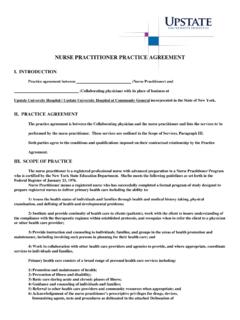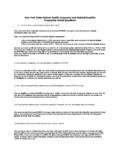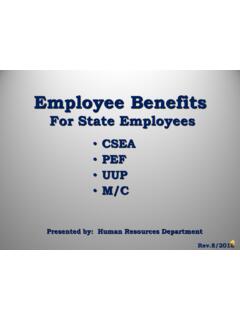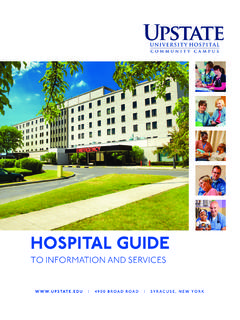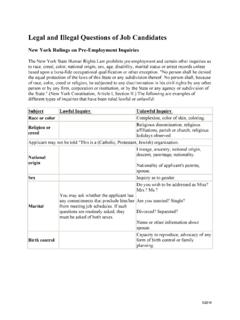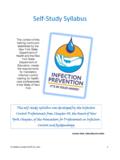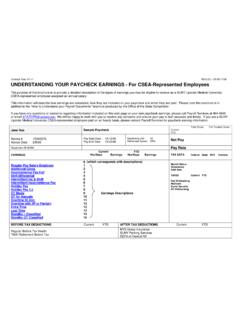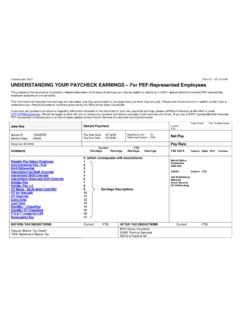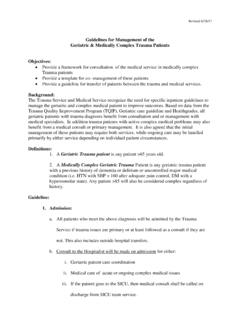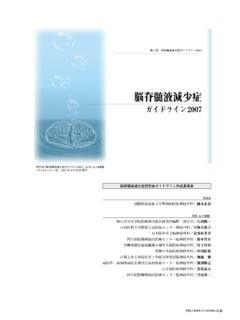Transcription of ICU Survival guide - Upstate Medical University | SUNY ...
1 1 | Page 2018 SUNY Upstate Medical University ICU Survival guide Ravi Doobay, Subrat Khanal, Lauren Krowl, Ryan Dean, Prathik Krishnan, Hassan Al-Khalisy Brian Pratt, Ioana Amzuta, Carlos Martinez-Balzano, Amit S. Dhamoon 2 | Page The ICU can be an intimidating and stressful environment. This manual is intended to help support Medical students, interns, and residents working in the ICU. Please be mindful that this manual is a guide for care in the ICU. Clinical treatment decisions are variable and nuanced depending on patient, nursing, and attending factors. 3 | Page Table of Contents: Day MICU Expectations Page 4 Night MICU Expectations Page 5 Sepsis Page 6 Respiratory Failure Page 12 Mechanical Ventilation Page 14 Liberation from Mechanical Ventilation Page 15 COPD Page 17 Asthma Page 19 GI Bleeding Page 20 DKA/HHS Page 23 Acid Base Disorders Page 24 Sedation Page 25 Delirium Page 29 ICU Drips Page 32 4 | Page Day MICU Expectations: - When a service asks for a consultation, confirm that an EPIC consult order is placed.
2 - Consults should be seen within 30 minutes. - Consults should be presented to either the Fellow or Attending. - If a patient is readmitted to the ICU, it is considered a bounce back if the same Attending or Fellow is on service. - If a patient is admitted to the ICU, an H&P note should be written. - If a patient does not require MICU admission, a consult note is written. - Transfers from outside hospitals should be admitted under the accepting physician. - If a patient is stable for transfer to the hospitalist service, the MAR needs to be contacted to determine the team/attending. - The Fellow directly contacts accepting hospitalists. - The ICU Resident signs out to the team resident. - Transfer summaries should be written when there is more than 48 hours of ICU level care - Death Note should be written in EPIC by pronouncing physician along with prompt EDRS completion - The Fellow or Attending should be notified with changes in goals of care, new hemodynamic compromise, procedure complications, or death followed by a family update - There should be timeouts before every procedure.
3 The placement of CVCs should be confirmed via manometry or transducing before dilating, it is an institutional policy. - Procedural consent is mandatory unless it is an emergency. - All procedures require a note. - MICU interdisciplinary conference is mandatory unless attending to patient care. 5 | Page Night MICU Expectations: - Confirm a Consult was placed in EPIC from the service asking for consultation - Residents should present the consult to the fellow after completion (irrespective of the diagnosis) - Any significant events such as: change in goals of care, hemodynamic compromise, procedure complication, or death should be notified to the fellow immediately with a family update - Bounce backs apply at night as well - MICU on call get the majority of admissions, however can give to the non-call team to make sure the difference in team size is not more than two patients - Changes to ventilator should be notified to the Fellow and RT - NEVER CHANGE THE VENTILATOR WITHOUT INFORMING THE RESPIRATORY THERAPIST AND ICU FELLOW!
4 6 | Page Sepsis: Key Terms: a. Systemic Inflammatory Response Syndrome (SIRS), need 2/4 positive a. Leukocytosis (>12,000 ), BANDEMIA, Leukopenia or (<4,000) b. Fever > OR Hypothermia < c. Tachypnea >20 breaths per minute d. Tachycardia >90bpm b. Sepsis: SIRS + Suspected Infection c. Severe Sepsis: Sepsis + Evidence of Organ Dysfunction d. Septic Shock: Severe sepsis + hypotension DESPITE adequate resuscitation (20-30cc/kg, 2L of IVF over 30min) or Pressor requirement is needed Sofa Criteria: Reference: Singer, M., Deutschman, C. S., Seymour, C. W., Shankar-Hari, M., Annane, D., Bauer, M., & Hotchkiss, R. S. 7 | Page (2016). The third international consensus definitions for sepsis and septic shock (sepsis-3).
5 JAMA, 315(8), 801-810. Reference: Singer, M., Deutschman, C. S., Seymour, C. W., Shankar-Hari, M., Annane, D., Bauer, M., .. & Hotchkiss, R. S. (2016). The third international consensus definitions for sepsis and septic shock (sepsis-3). JAMA, 315(8), 801-810. Treatment: 1) Fluid resuscitation is essential! a. Administer intravenous fluids aggressively. In general, give 30 mL/Kg of BW for fluid administration b. Consider central line placement if needed for pressor support. Consider arterial line if significant hemodynamic instability. c. Give 3 L of crystalloid fluids immediately d. Will need on average 5L in the first six hours 8 | Page e. Crystalloids such as NS ($2 per bag) are as effective as colloids ($40 per bag) such as Albumin 2) Antibiotic administration early!
6 A. Give appropriate broad-spectrum antibiotics early. Consider Vancomycin and Zosyn, if concern for ESBL can use Carbapenem such as Meropenem. Consider double pseudomonas coverage when mortality is over 25%. Mortality can be calculated with Apache II Score. b. ICU Mortality increases by 7% per hour of no antibiotics in hypotensive patients. Culture before antibiotic administration with blood, sputum, and urine cultures. In particular situations consider meninges and bone as sources of infection. c. Lactic Acid is recommended, the rate of decrease with treatment is a better predictor than the absolute value. 3) Vasopressors a. Start Pressors early if after adequate fluid resuscitation. MAP remains <65 mmHg. Pressors can be started and continued peripherally until patient is stabilized.
7 There is NO policy against starting pressors peripherally. b. Start with norepinephrine first. Consider adding vasopressin next. Agents that can be used as third pressors: epinephrine, dobutamine, phenylephrine. Dopamine increases the rates of arrhythmias and should be used judiciously. 9 | Page Vasopressors: Used for Shock when MAP < 65 Causes of Shock: 1) Septic Shock 2) Cardiogenic Shock 3) Neurogenic Shock 4) Anaphylactic Shock Goal Mean Arterial Pressure is generally > 65 mm Hg. However this goal can vary in the setting of neurological injury such as stroke or intracranial hemorrhage. There is sufficient evidence that Norepinephrine should be the first vasopressor used in all situations even if used peripherally. If blood pressure does not increase appropriately with norepinephrine, either vasopressin or epinephrine can be next.
8 Dopamine has shown an increase in mortality and arrhythmias, and should be used c autiously. Phenylephrine is most commonly used for neurosurgical or spinal injury. In severe Congestive Heart Failure exacerbations ionotropic agents such as Dobutamine and Milnirone can be used, however due to their Beta-2 receptor stimulation, hypotension can worsen and concominant use of norepinephrine may be needed. Below are the specific receptors that these agents work on. Vasopressor Alpha 1 Beta 1 Beta 2 Norepinephrine +++ + ___ 10 | Page Vasopressin _____ _____ ___ Epinephrine +++ +++ +++ Phenylephrine +++ _____ ___ Dopamine ++ (High Dose) +++ +++ Dobutamine _____ ++ + Milrinone _____ _____ ___ Vasopressin works on V2 receptors stimulating the RAAS system, which increases blood volume, cardiac output, and arterial pressure.
9 Milrinone is a phoshodiesterase-3 inhibitor and should be used with caution in patients with renal dysfunction. Suggested order for Vasopressor Support for Septic Shock 1) Norepinephrine 2) Vasopressin 3) Epinephrine 4) Phenylephrine 5) Dopamine (If there is bradycardia, keep in mind Dopamine can increase mortality) * Vasopressin and or Epinephrine can be interchanged at 2/3 Reference: Singer, M., Deutschman, C. S., Seymour, C. W., Shankar-Hari, M., Annane, D., Bauer, M. & Hotchkiss, R. S. 11 | Page (2016). The third international consensus definitions for sepsis and septic shock (sepsis-3). JAMA, 315(8), 801-810. Vitamin C, Steroids, and Thiamine The early use of IV Vitamin C, Hydrocortisone, and Thiamine has been shown to decrease mortality in septic shock, along with preventing organ dysfunction.
10 However these findings are recent and more data needs to be collected to validate these claims. Refernce: Marik, P. E., Khangoora, V., Rivera, R., Hooper, M. H., & Catravas, J. (2017). Hydrocortisone, vitamin C, and thiamine for the treatment of severe sepsis and septic shock: a retrospective before-after study. Chest, 151(6), 1229-1238. Steroids in Septic Shock: There is a thought that it is actually the steroids that result in the mortality benefit. Annane et al which is a 1241 person study showed that 50 mg of IV Hydrocortisone q6h and Fludrocortisone 50 ug daily via an NG tube reduced 90 day mortality in septic shock patients compared to a placebo group, along with vasopressor free days and organ failure free days. However once again there is more data that needs to be collected on these new intervention for sepsis.
